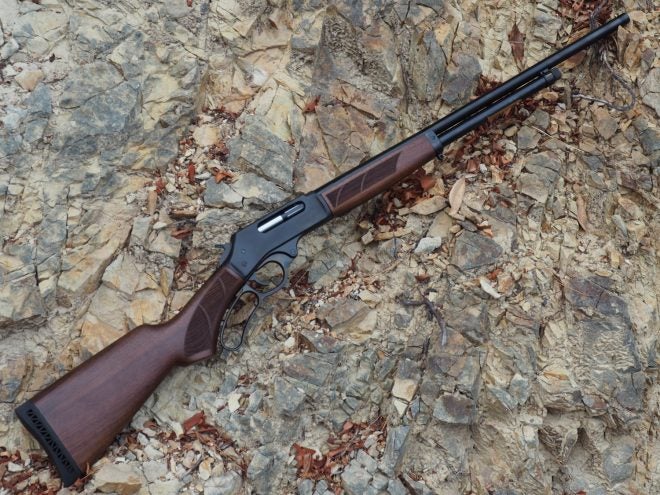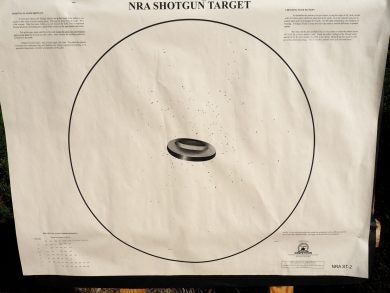Some firearms, while very fun to shoot, do not command a lot of interest or attention at the range. The new Henry lever action shotguns in .410, however, not only are a blast to bust clays with, but I had more people coming up and asking questions than with any other shotgun I’ve ever brought to the range. While shattering multiple clays out of the sky while working a lever was a new experience for me, it became a whole lot of fun. In fact, the Henry H018-410 has become my favorite gun to take to long afternoons of busting clays.
Specs:
Per Henry:
Model Number H018-410 Action Type Lever Action Shotgun Caliber .410 Bore Capacity 5 Rounds Barrel Length 24″ Barrel Type Round Blued Steel Rate Of Twist Smooth/Full Invector Style Choke Overall Length 44.5″ Weight 7.54 lbs. Receiver Finish Blued Steel Rear Sight None Front Sight Vertical Blade Scopeability N/A Stock Material American Walnut Buttplatepad Black Ventilated Rubber Recoil Pad Length Of Pull 14″ Safety Transfer Bar Best Uses Target/Hunting/Bird Shot Embellishments / Extras Swivel Studs. Can use 2 1/2″ shells only. Screw in Invector Choke M.S.R. Price $902.00
(Author’s note: Though the “scopeability” says “N/A”, the H018 does indeed have a drilled and tapped receiver, making the mounting of a red dot easy.)
First Impressions
The H018-410 comes in Henry’s standard white cardboard box. In the box was the firearm, a manual, and a choke wrench. Upon first sight, with its curved lever, larger receiver and pistol grip style stock, this shotgun appears to be a standard steel Henry in .45-70, but is one key external difference. The 24″ model is the only Henry to have a front bead sight. At 7.54 pounds, the Henry H018 is certainly not the lightest repeating .410 shotgun, but the weight is well balanced on the forward part of the receiver. Furthermore, the gun carries and swings quite well. Subjectively, I felt that the weight never became tiresome during extended range sessions, and the shotgun wasn’t bothersome while hiking around with it slung (I used a “Claw” sling attached to the factory-provided studs) or at port arms.

The Henry H018 with magazine tube and wrench
Operation is identical to a standard Henry. Loading is accomplished via giving the magazine end cap a slight turn, sliding the tubular magazine forward, and inserting shells in a window. One then replaces the magazine tube and the shotgun is ready to be charged via the lever. There is a transfer bar safety as well, for safely carrying with a round chambered in the field.
Printing Patterns
The removable “Invector style” (compatible with Browning .410 Invector series) full choke printed very useable patterns at 25 yards with Federal and Estate loads from #4 up to #8-1/2. (Thanks to the good folks at Henry, Federal was gracious enough to send me some of their .410 loads for this review). For skeet or trap shooting, Federal Gold Medal #8-1/2 printed an excellent, even pattern. It demonstrated good pellet density all within a 14×16 rectangle. Only 3 pellets were outside of the target circle. Federal’s Game-Shok in #6 would make a good small game load for this shotgun, printing a nice even circle on target. Estate’s #7-1/2 HV410 load, while the cheapest of the bunch, printed an uneven, scattered pattern. While all pellets were within the target circle, blank spots abounded. Most impressive to my colleagues and I was the pattern exhibited by Federal’s personal defense load in #4 shot. At 25 yards, the pattern had no pellets missing, and all pellets were within the average width of a human torso. This would be a very useable load if this gun was used for defensive purposes.

Removable Choke
While patterning, I had time to concentrate on the trigger press. The trigger on the H018 is about perfect for a shotgun, not too heavy, with a crisp, clean break. The trigger quality continued to be an asset during fast paced trap shooting, as I just had to apply slight pressure to get it to break cleanly during my swings onto the clays.
Crushing Clay
Patterns don’t mean anything if a shotgun does not point and swing naturally. I had two extended range sessions with the H018, both with beginning and advanced shotgunners. The first morning, I had a blast vaporizing clay after clay. The only hurdle to get over was the mental hurdle of shouldering a lever action like a shotgun, not a rifle. After the first box of shells, I was only missing 2 or 3 clays a round, off a “fast” tuned thrower. Hitting the second clay was very easy, as the lever worked smoothly and quickly to eject and chamber a new shell. A group of beginners showed up with some instructors, and showed immediate interest. Even the instructors at first were somewhat bemused, thinking perhaps that I was shooting clays with a rifle at first! I offered them some rounds with the H018, and all ten of them were takers including the instructors. Though about half of the students thought the gun was somewhat heavy for a .410, all ten shooters could easily bust clays with little instruction. The shooters varied in size from 5′ to 6’5″ and all had a good time with the H018. I concluded that the proportions of the gun seem to be a good size to fit most shooters. The new shooters that were small of stature or recoil-shy really appreciated the almost total lack of recoil. The only issues with the gun that I saw (and this applied to the instructors, too) was some shooters inexperienced with quickly working a lever action would either short stroke the action, or not close it all the way.

A full movement of the lever requires movement slightly past 90 degrees.
The next day, I shot with a larger group of regular shotgunners, most of whom who have over a quarter century of clay shooting experience. Most everyone wanted a try with the lever action .410. There were no complaints from this experienced group about the weight. The overall consensus was that the shotgun was balanced well, and swung easily from target to target. Only a few clays were missed with the H018 across the board. All were in agreement that when it comes to lever action shotguns, the H018 blows the 1887/1901 series out of the water in terms of reliability, quality of manufacture, and utility. I think some of the group will be new owners of the gun by the time this review goes up.
Overall Impressions/Final Thoughts:
The H018-410 is a nice addition to anyone’s shotgun collection. It would make a great camp gun for harvesting small game or grouse. Hunting for upland birds, doves, or quail would be a good role for it as well. For a recoil sensitive individual, it could also be ok for defensive purposes, paired with the right loads. For trap, skeet or 5-stand, the H018 is a fun shotgun to change things up from the break-open or semiauto game. The lack of recoil makes for unbruised shoulders at the end of the day as well, if that’s something one minds. The H018 is, however, somewhat “overbuilt”. This extra heft and weight is an asset in that it makes for a barrel that won’t burn one’s fingers even after 200 shells straight. I would, however, like to see a model in the future that trims the length, weight, receiver and barrel thickness to make a lighter, shorter game-getter. Objectively, the H018-410 patterned well, and was malfunction free for the roughly 400 shells I fired through it. Subjectively, I found the H018-410 to be novel, different , and highly amusing shotgun to bust clays with, and appreciated the quality of manufacture and reliability of the gun. Though an older technology, there’s just something extra fun about shooting quickly with a levergun that gets more amusing when you throw flying clays into the mix.
For more information, visit Henry USA.
Thanks Federal Ammunition for the shells, and to Hughston Shooting School for logistical support
 Your Privacy Choices
Your Privacy Choices



